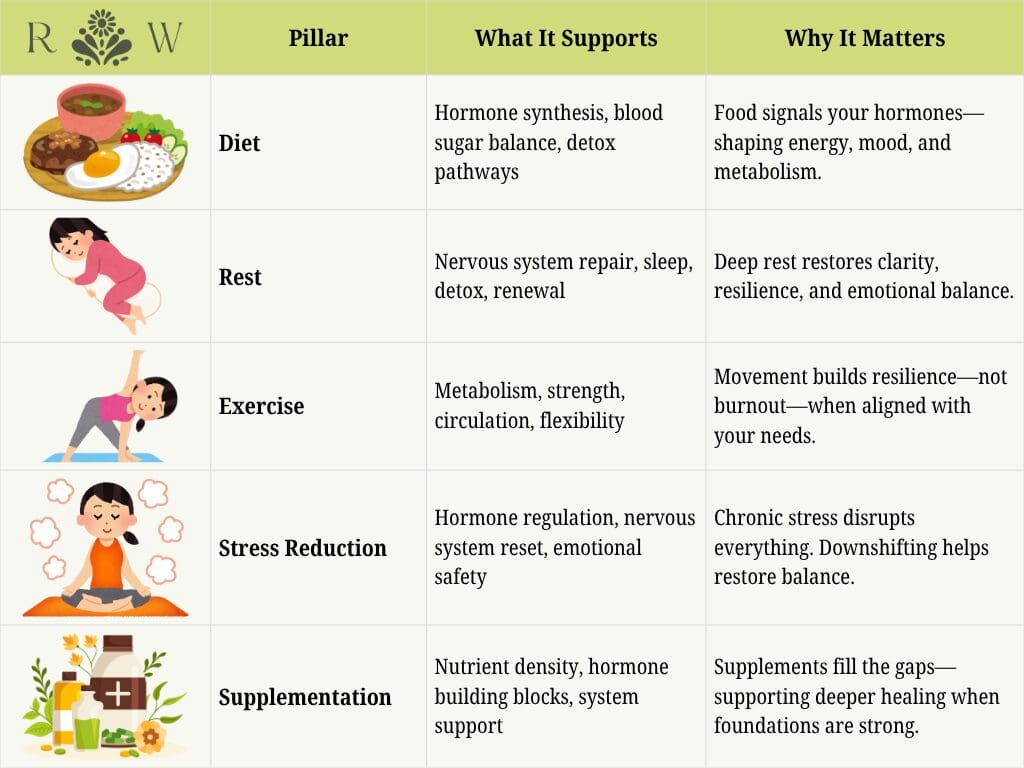A gentle path to restore your rhythm, rebuild resilience, and reconnect with the woman you’re becoming.
Welcome to Part 2 of a Two-Part Series on Hormones and Womanhood
In the first part of this series, we uncovered how hormones speak through real-life symptoms—before labs or diagnoses. Now, we turn toward the deeper undercurrents behind those rhythms—subtle influences that accumulate over time, quietly shape our hormonal landscape, and contribute to healing hormonal imbalance through a whole-person lens.
In this Part 2, we explore:
- How life seasons like caregiving, grief, or raising children intersect with hormone health
- The hidden stressors that fuel Metabolic Chaos®
- Why conditions like endometriosis, PCOS, shortness of breath linked to grief, and long COVID reflect deeper imbalances
- Why functional lab testing, body-based therapies, and compassionate coaching are often key to true restoration
- How the D.R.E.S.S. Framework creates a personalized path to healing—from toxins and trauma to infections and gut stress.
Hormonal imbalance is rarely caused by just one thing. More often, it’s the result of a convergence of hidden stressors, layered life experiences, and underlying biological sensitivities. Together, these create what we call Metabolic Chaos®—a breakdown in the body’s ability to maintain balance under pressure. Understanding this pattern is often the turning point in restoring harmony across the entire system.
This blog is written for women—and for those who care about them, walk beside them, and want to better understand the journey through the seasons of womanhood.
Note: This post goes deeper and may take time. Read what resonates. Your pace is welcome here.
🌿 Life Seasons and Hormone Rhythms in Women
Our hormonal patterns may follow biological stages—but our lives rarely unfold so neatly. The roles we play, the responsibilities we carry, and the relationships we nurture add complexity that deeply shapes how we feel. These life seasons can heighten symptoms, stretch resilience, or spark personal insight. Understanding this dynamic invites us to meet our bodies with grace—right where we are [8][9].
Our biology follows rhythms, but life rarely stays on script. The roles we carry shape how our hormones shift and respond.
Everyday Life Rhythms
🌿 Singlehood — Brings freedom and independence, but can also carry loneliness. Cortisol may rise during career building, identity exploration, or unmet expectations.
💕 Marriage and Partnership — Brings connection and shared roles, but also reveals differences. Hormones shift with emotional safety, intimacy, or the unspoken tension that can build when two people move through life in different rhythms.
🍼 Mothering Young Children — A beautifully intense season. Oxytocin rises through bonding, while cortisol often increases from broken sleep, overstimulation, and constant caregiving.
📚 Raising School-Age Kids and Teens — Often overlaps with perimenopause, stretching hormonal and emotional capacity as we support their growth while navigating our own changes.
🧺 Empty Nest — Brings both space and sadness. As hormones settle, it often stirs questions of purpose and identity—reawakening dreams or creative callings we’d set aside. With fresh clarity, we’re invited to rediscover what brings meaning now.
🌟 Grandmotherhood — Often brings renewal. With calmer hormones, many women feel a fresh wave of energy, clarity, and purpose as they reconnect with family and rediscover themselves.
Tender Seasons That Reshape Us
❤️🩹 Caregiving — Whether supporting aging parents, special-needs children, or others, this role carries emotional and physical strain. Prolonged stress can weaken immunity and destabilize hormonal balance.
🙏 Grief and Loss — Touch us at the deepest hormonal level, disrupting cortisol, melatonin, and mood. This tender season can disturb sleep, appetite, and emotional balance—requiring deep gentleness and time to heal.
🩺 Living with Chronic Illness — Brings its own rhythm and reckoning. Chronic symptoms can alter energy, identity, and relationships. Navigating life with a condition like autoimmune disease, fibromyalgia, or long COVID requires both fierce resilience and deep rest.
Chronic illness reshapes your season—but doesn’t steal your story. This phase calls for compassion, pacing, and learning to live in partnership with your body.
⚡️ Metabolic Chaos®: When Chronic Stress Disrupts Hormones
Women’s lives are rarely linear. Multiple seasons often overlap—raising teens, caring for aging parents, launching a business, or grieving while managing daily demands. These visible pressures don’t just move through us—they build up.
Beneath the Surface: The Invisible Load
Hidden stressors quietly accumulate beneath daily life:
- Low-grade infections (from gut imbalances, chronic sinus or dental issues, and latent viruses) and chronic inflammation (driven by poor sleep, stress, and blood sugar imbalances)
- Environmental toxins such as mold, pesticides, heavy metals, amalgam (silver/mercury) dental fillings, microplastics, and hormone-disrupting chemicals (found in plastics, fragrances, cookware, and personal care products)
- Invisible exposures including poor air and water quality and electromagnetic frequencies (EMFs) from Wi-Fi, cell phones, and smart devices—often unnoticed, but constantly present
Layer in food sensitivities, leaky gut, leaky brain, and unresolved trauma—and the body begins to falter under the weight.
These burdens may not show up on standard lab tests—but they’re still felt. And they matter.
Metabolic Chaos® in Real Life
All of this builds into what we call Metabolic Chaos®—not one root issue, but a constellation of overwhelm that touches every part of how we feel and function.
You may notice:
- Feeling scattered and out of sync – fatigue, anxiety, mood swings, brain fog, digestive distress, or disrupted sleep
- Diagnosed conditions – PCOS, endometriosis, fibroids, long COVID, autoimmunity, chronic infections
- Misunderstood symptoms – asthma, skin flares, or panic attacks rooted in unresolved grief or nervous system overload
Symptoms Are Signals—Not the Whole Story
What we often call “symptoms” may actually be the body’s intelligent response to chronic, layered stress.
This isn’t fleeting—it’s cumulative, building over time until the body can no longer compensate. What may seem like random fatigue, anxiety, pain, or hormonal disruption is often the body’s attempt to adapt under pressure.
While it’s tempting to search for one root cause or one fix, meaningful healing begins when we zoom out and see the whole picture.
Hormone health isn’t just about reacting to symptoms—it’s about supporting the whole person, with compassion, context, and care that meets them where they are.
When life layers on, symptoms don’t just appear—they’re signals linked by deeper patterns.
🔬 Finding the Path Forward
After the toll of Metabolic Chaos®, many women ask: Where do I even begin? When symptoms pile up and nothing helps, it’s easy to feel lost—or wonder what’s been missed.
This is where functional lab testing offers clarity. Rather than chasing symptoms, it asks: Where is function? How much has been lost? And where has it been lost?
These tests help assess the body’s core systems—like hormone balance, detoxification, digestion, gut health, energy metabolism, and oxidative stress. When we connect these insights to your lived story, we begin to uncover hidden stressors and identify where your vital reserves are running low—often the very places driving dysfunction. These are healing opportunities—places where we can begin restoring function with care and precision.
That’s where the D.R.E.S.S. Framework steps in—as the bridge between insight and transformation. It helps translate what we’ve uncovered into meaningful action, with clarity, compassion, and a personalized plan that meets you in your current season and supports where you’re ready to grow.
Transformation begins when insight becomes aligned action—and when you feel seen and supported.
🌿 The D.R.E.S.S. Framework: A Whole-Person Path to Healing
The D.R.E.S.S. Framework is a flexible, whole-person guide designed to support the healing opportunities uncovered through functional lab testing and your lived experience. Built around five key pillars—Diet, Rest, Exercise, Stress Reduction, and Supplementation—it offers a practical way to begin restoring rhythm and resilience. Each pillar creates momentum on its own, but when practiced together, they generate lasting, whole-body change.
Originally developed by Functional Diagnostic Nutrition® (FDN), this approach has been expanded here to reflect clinical insight and the real-life experiences of women navigating hormonal stress and life transitions.
Once we understand what’s out of balance—through functional insights and the story your body is telling—we begin to rebuild with intention. That process starts by meeting your most immediate needs with grounded, compassionate support.
The five pillars of D.R.E.S.S. offer exactly that. They provide structure without rigidity, guidance without overwhelm. And while each one can stand on its own, it’s their synergy that creates real momentum. When these areas are nourished together, they generate a rhythm your body can trust—one that supports healing, resilience, and sustainable change from the inside out.
Healing begins when we stop chasing symptoms and start supporting the whole person. It’s not about doing everything at once—but restoring rhythm, one layer at a time.

The D.R.E.S.S. Framework unites five core pillars—working in synergy to restore rhythm, resilience, and whole-person healing.
Each pillar plays a distinct role in whole-person healing. Here’s what each one supports—and why it matters.
What follows is a practical place to begin.
Each pillar introduced below offers a simple, foundational step to start restoring rhythm and resilience. The deeper work—personalized to your biology, lived experience, and functional insights—extends beyond the scope of this blog and is explored more fully in the 90-Day Wellness Journey.
🥗 Diet: Nourishing Your Hormonal Foundation
Food is one of the most immediate and powerful ways to support hormone health. The goal isn’t restriction—it’s nourishment. It’s not about what we remove, but what we bring in.
Yes, some foods may need to be limited—especially those that spike blood sugar, trigger inflammation, or burden detox pathways. But the real key is substitution. When we fill the plate with nutrient-dense, hormone-supportive foods, the body moves toward balance [1].
What we eat directly shapes hormonal health by supporting:
- Blood sugar stability for mood, energy, and cortisol
- Anti-inflammatory nutrients that protect the brain and support hormone metabolism
- Detoxification pathways that clear excess hormones
- Essential proteins (with collagen) and healthy fats for hormone building blocks and tissue repair
- Gut-friendly fibers for microbiome and estrogen clearance
This is where personalization matters. Some women thrive on more fiber and plants, others on healthy fats and protein. The best diet is the one that helps your body feel safe, nourished, and resilient. 🌾Seed cycling—using flax, pumpkin, sunflower, and sesame seeds in sync with your cycle—is another gentle way to support estrogen and progesterone balance through food.
Approaches like Dr. Mindy Pelz’s hormone-supportive fasting rhythms and Dr. Georgia Ede’s brain-healthy nutrition can help tailor food choices to your current season and needs [2][5].
Food isn’t just fuel—it’s information. Every bite reshapes your hormonal terrain.
😴 Rest: Beyond Sleep to True Restoration
Rest is more than sleep. It’s how we recover from what life wears down—physically, emotionally, mentally, and spiritually. True restoration begins when we create space for the body to feel safe and recalibrate [4].
In hormonally intense seasons, rest often feels out of reach. Falling asleep is hard. Staying asleep, harder. And waking? Anything but refreshing. But real renewal goes beyond sleep. It comes from rhythms that help the nervous system downshift so the body can begin to repair.
Dr. Saundra Dalton-Smith describes seven types of rest [6]—each one supporting a different part of our well-being:
- Physical rest — Sleep that supports healing, and gentle movement that soothes rather than strains.
- Mental rest — Pausing the mental noise—stepping away from decision-making, planning, and overthinking to let the mind exhale.
- Sensory rest — Pulling back from constant input—like screens, noise, and clutter—to soothe overstimulated senses and reclaim calm.
- Creative rest — Space to engage with beauty, wonder, or imagination—without needing to perform, produce, or explain.
- Emotional rest — Having space to express how you truly feel—without filters, without pressure to perform or please others.
- Social rest — Relationships that restore emotional energy—where you feel seen, safe, and supported, rather than depleted.
- Spiritual rest — Connecting beyond the physical and mental to experience belonging, love, acceptance, and purpose. Whether through faith, awe, or quiet reflection, it’s a reminder you’re not alone.
Tending to these layers can help ease the body out of survival mode. It invites renewal—without turning rest into another task to perfect.
Rest isn’t a luxury—it’s a requirement for balance and resilience.
🏃♀️ Exercise: Movement That Matches Your Season
Hormonal balance doesn’t require punishing workouts—it invites movement that aligns with your body’s needs. Exercise becomes less about control—and more about connection.
When chosen wisely, movement supports blood sugar regulation, improves sleep and mood, reduces inflammation, encourages lymphatic drainage, and helps your body produce and clear hormones more efficiently.
The key is honoring how you feel—not pushing through based on what you think you should do. Movement should build resilience, not deplete it.
A well-rounded movement practice can include:
- Strength training — Protects bones, builds muscle, and supports metabolism. Dr. Gabrielle Lyon calls muscle “the organ of longevity” for good reason—it’s vital for hormonal and metabolic health [7].
- Gentle yoga — Enhances circulation, improves flexibility, and soothes the nervous system.
- Walking — Offers a grounding daily rhythm, especially supportive during high-stress seasons or when cortisol is elevated.
- Joyful or playful movement — Lifts your mood and restores a sense of ease—whether dancing, swimming, rebounding to support lymphatic flow, or simply moving freely.
- Mobility and stretching — Releases tension, increases flow, and restores your body’s natural rhythm.
- Breath-led or energy-based practices — Reconnect body and mind while regulating stress. Practices like Qigong or Tai Chi offer deep grounding.
- Sauna sessions — Promote detoxification and support hormonal clearance through improved circulation and lymphatic drainage.
Move your body in a way that honors your energy—not in a way that depletes it.
🧘♀️ Stress Reduction: Calming the Storm Within
Chronic stress is one of the most overlooked disruptors of hormonal health. It amplifies imbalances and slowly unravels even our best efforts to heal. That’s why nervous system regulation isn’t just helpful—it’s essential.
Stress touches each of us in unique ways, so our responses must be equally personal. We can’t always remove stress entirely, but we can guide it, soften it, and lessen its grip. What matters most is expanding our ability to recover—creating rhythms that restore and sustain us rather than wear us down.
- Honor your natural rhythms — Your body’s inner clock is guided by light and darkness. Morning sunlight sparks cortisol to wake you up, while evening darkness allows melatonin to rise for rest and repair. Sunlight’s shifting wavelengths through the day also help regulate hormones like leptin, which supports satiety and balanced energy. When sleep, light, and meals align with these rhythms, your body feels calmer, more resilient, and better able to handle stress.
- Reconnect to peace and purpose — Simple practices like prayer, journaling, or quiet time in nature ground you in something larger than stress, restoring perspective and calm.
- Choose restorative over numbing — Reach for activities that replenish: read, walk, soak in a warm bath, or express yourself creatively. These soothe and renew, unlike endless scrolling, which often leaves you more drained.
- Nurture supportive relationships — Spend time with people who see and accept you as you are. Give yourself permission to advocate for your needs with kindness, rather than shrinking back or overextending. Choose spaces where you can be your full self and feel genuinely supported.
- Protect your energy — Say no to commitments that deplete you. Set boundaries around emotional labor and create space—physically and emotionally—for what truly restores you.
- Lighten your hidden load — Small things can quietly add stress over time. Mold, EMFs, and chemicals in products or kitchen tools can weigh on the body. Industrial seed oils, gluten-containing foods, processed sugars, and items with artificial flavors, colors, or fillers can do the same. Gentle changes over time give your body and nervous system more space to feel clear, calm, and supported.
- Engage the body directly — Somatic therapies like fascia release, breathwork, craniosacral work, EFT (tapping), TRE (Tension and Trauma Releasing Exercises), and Energy Medicine (such as the Eden Method) help release stored stress and reset the nervous system—going beyond mental processing alone.
Even one of these practices—done regularly—can begin to calm the storm within. As the nervous system settles, hormones are better able to find their rhythm too [9].
You can’t eliminate all stress—but you can choose how you recover.
💊 Supplementation: Support, Not Shortcuts
Supplements are meant to complement, not replace, the foundations of health. Nourishing food, restful sleep, movement, and stress recovery remain the cornerstones. When chosen with care and added gently, supplements can provide an extra layer of support—helping to fill gaps and ease the load on your system.
Because every body is unique, what works well for one person may not suit another. That’s why it’s important to let your needs, sensitivities, and capacity guide each choice. With the right support, supplements can be safe, strategic, and aligned with your biology. And always with balance in mind—too much, too soon can create unnecessary strain on the liver, digestion, or detox pathways. Think of supplements as gentle allies that enhance your foundation, not replacements for it.
With that in mind, here are some core categories of supplements that can offer meaningful support for hormone balance—working alongside the foundations of nourishment, rest, movement, and stress recovery:
- Digestive capacity support helps maintain healthy stomach acid and enzyme activity, allowing food to break down effectively and nutrients to be absorbed with ease. Well-supported digestion also strengthens gut–brain–nervous system signaling and helps keep hormone communication in balance.
- Detoxification support is the body’s cellular clean-up, helping the liver process excess hormones, toxins, and metabolic waste. Just as important, it supports gentle drainage pathways—the lymphatic system, colon, kidneys, lungs, and skin—that carry waste out of the body. Detox works from inside the cell to the space around it, while drainage moves those byproducts all the way out of the body.
- Foundational nutrients like B-vitamins and omega-3s support hormone production and metabolism. Equally important is mineral balance—from electrolytes such as magnesium, potassium, sodium, and calcium to trace minerals like zinc, selenium, and copper. These work best when supplied through nourishing foods, with supplements added only to fill gaps.
- Adaptogens such as ashwagandha or rhodiola can gently build resilience and support healthy cortisol rhythms. They are most helpful when used to complement your body’s natural foundation of daily nourishment, movement, and restorative rhythms.
- Gentle hormone support may include botanicals like evening primrose oil to ease breast tenderness, Shatavari to nourish the reproductive system, or Dong Quai to support circulation and ease monthly discomfort. These botanicals work best when used as subtle additions, supporting the body alongside steady lifestyle practices.
- Bioidentical hormone replacement therapy (BHRT)—whether prescription or over-the-counter—can be a helpful layer of support when guided with care. It is most beneficial when integrated on top of nourishing routines and restorative daily rhythms, rather than used in place of them. [3][10]
Supplements aren’t silver bullets—they’re gentle nudges that work best when your foundation is strong.
The D.R.E.S.S. framework is about alignment—offering a rhythm of care that supports your body with consistency, compassion, and ease. By building habits that match your capacity and layering in change over time, healing becomes not only possible, but sustainable and deeply personal.
This isn’t a fixed formula—it’s a rhythm of reconnection. A way to respond to your body’s needs with presence and care, one gentle shift at a time. Wherever you begin, there’s a path forward that honors your pace—not perfection.
🌸 Embracing the Journey, Together
This journey isn’t just about managing symptoms—it’s about attuning to your body’s quiet messages and honoring its inner wisdom.
It’s an invitation to Sacred Stewardship: listening with care, responding with gentleness, and honoring the rhythms of biology and life—not as problems to solve, but signals to receive. It’s choosing to care for your body the way you would someone you love.
The D.R.E.S.S. Framework brings structure, but true alignment happens when those rhythms connect with your lived experience—your biology, your story, and the season you’re in. Healing unfolds when we meet ourselves with compassion, curiosity, and care.
Hormonal symptoms aren’t failures—they’re feedback. They remind us that the body is responding intelligently, even when the signals feel inconvenient or unclear. These signals are invitations to pause, listen, and respond with care.
So instead of asking, “What’s wrong with me?”—ask, “What is this season asking of me?”
If you’re ready to feel grounded, resilient, and supported—and want guidance that honors your season, your story, and your pace—explore our 90-Day Wellness Journey.
Together, we’ll craft a D.R.E.S.S. plan rooted in both insight and intuition—one that meets you with compassion and helps you move forward in rhythm with your life.
This journey isn’t about returning to who you were—it’s about becoming who you were always meant to be. And you’re not meant to walk it alone.

The meadow calls us back—where joy runs free, the breeze carries laughter, and every step is a return to wonder.
🌀 Missed Part 1?
We explored how hormones first speak through mood, energy, sleep, and life transitions—long before they ever show up on a lab test. 👉 Read Part 1 here
📚 References
1. Anna Cabeca, DO, The Hormone Fix, 2019.
2. Mindy Pelz, DC, Eat Like a Girl, 2024.
3. Felice Gersh, MD, The Science of Bioidentical Hormones for Better Health After Menopause, 2023.
4. Lisa Mosconi, PhD, The Menopause Brain, 2024.
5. Georgia Ede, MD, Change Your Diet, Change Your Mind, 2024.
6. Saundra Dalton-Smith, MD, Sacred Rest, 2017.
7. Gabrielle Lyon, DO, Forever Strong, 2023.
8. InspiredByFamilyMag.com, Seasons of a Woman’s Life, 2020.
9. Mark Buchanan, Spiritual Rhythm, 2010.
10. Quicksilver Scientific, Clinical protocols and product formulations, 2024.
📩 Let’s Connect
Part 1 helped you tune into your hormonal signals. Part 2 revealed the deeper stressors that pull those rhythms off course—and how whole-person healing can guide you back to balance.
If your body is asking for more support, and life feels layered, you don’t have to walk this next stretch alone. Whether you’re navigating hormone shifts, stress, or a season of transition, I’d be honored to walk with you.
Let’s walk forward together—with grace and wisdom.

keep browsing
I help women reconnect with their bodies and create lasting wellness with personalized nutrition, functional health, and energy practices—so your body can thrive. Feeling wired yet tired, struggling with fatigue, sleep disruptions, digestive issues, or hormonal imbalances? You’re in the right place.
Meet your coach, Ruth!
You Might Also Like...

Chloey’s story is one of patience, prayer, and steady progress. Through diet, therapy, and faith-filled parenting, her family discovered that growth may be slow, but it blossoms when nurtured with love, wisdom, and consistency—offering hope for every step of the journey.

Vitamin D is more than sunshine or supplements. Behind the numbers, your body manages savings and spending accounts, cofactors like magnesium and vitamin A, and patterns that labs help reveal. Seeing the full system makes it easier to choose wisely and stay balanced.

Explore how the Gage R&R concept—practiced in engineering—offers a helpful lens for understanding variability in functional health lab testing. Lab results aren’t always clear-cut; deeper insight comes from considering timing, environment, and your body’s real-life context—not just numbers on a report.
How Can I Support You?
Ruth helps women reclaim clarity, confidence, and vitality through a whole-person approach to healing. She integrates lab insights, energy medicine, and personalized wellness strategies to support each client’s unique path to balance and resilience. While she doesn’t diagnose or treat conditions, she helps uncover lifestyle and environmental factors affecting well-being—and equips women with lasting tools to rebuild their health and confidently support those they love.
